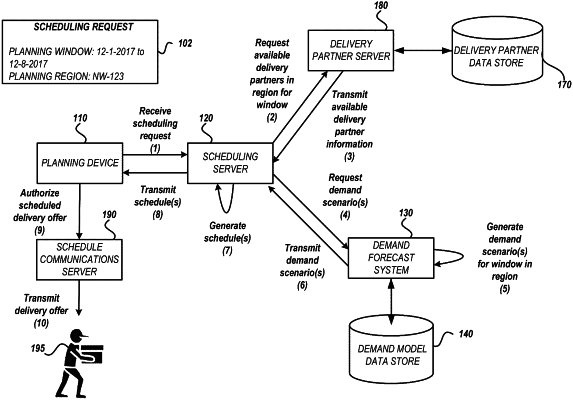| CPC G06Q 10/06311 (2013.01) [G06N 20/00 (2019.01); G06Q 10/0835 (2013.01); G06Q 10/0838 (2013.01); G06Q 50/28 (2013.01); G06Q 10/04 (2013.01)] | 20 Claims |

|
1. A computer-implemented method comprising,
under control of one or more processors,
for each delivery partner of a plurality of delivery partners, generating, using a first machine learning model, a probabilistic scorecard for the delivery partner, the probabilistic scorecard indicating for a particular timeslot, a probability that the delivery partner will successfully complete a delivery, wherein the first machine learning model is trained at least in part on a response by the delivery partner to offers;
receiving a request, from a planning device, for a schedule for deliveries in a region over a period of time;
obtaining, using an index associated with the region, a uniform resource identifier, the uniform resource identifier identifying a network location of a second machine learning model appropriate for generating the schedule;
obtaining, from the network location, the second machine learning model;
identifying, from the plurality of delivery partners, a first set of available delivery partners and a second set of available delivery partners based at least in part on the request for the schedule for the deliveries, wherein the first set of available delivery partners includes one or more available delivery partners, and wherein the second set of available delivery partners includes one or more available delivery partners;
generating, using the second machine learning model, a first potential schedule for the deliveries for each available delivery partner of the first set of available delivery partners over the period of time, wherein the first potential schedule includes a first set of offers to satisfy the deliveries, and wherein input to the second machine learning model comprises information describing the deliveries, the period of time, delivery partner information for each delivery partner of the first set of available delivery partners, and the probabilistic scorecard for each delivery partner of the first set of available delivery partners;
generating, using the second machine learning model, a second potential schedule for the deliveries for each available delivery partner of the second set of available delivery partners over the period of time, wherein the second potential schedule includes a second set of offers to satisfy the deliveries, and wherein input to the second machine learning model comprises information describing the deliveries, the period of time, delivery partner information for each delivery partner of the second set of available delivery partners, and the probabilistic scorecard for each delivery partner of the second set of available delivery partners;
generating a comparison of the first potential schedule and the second potential schedule;
identifying the schedule for the deliveries from the comparison; and
transmitting the schedule for the deliveries to the planning device.
|